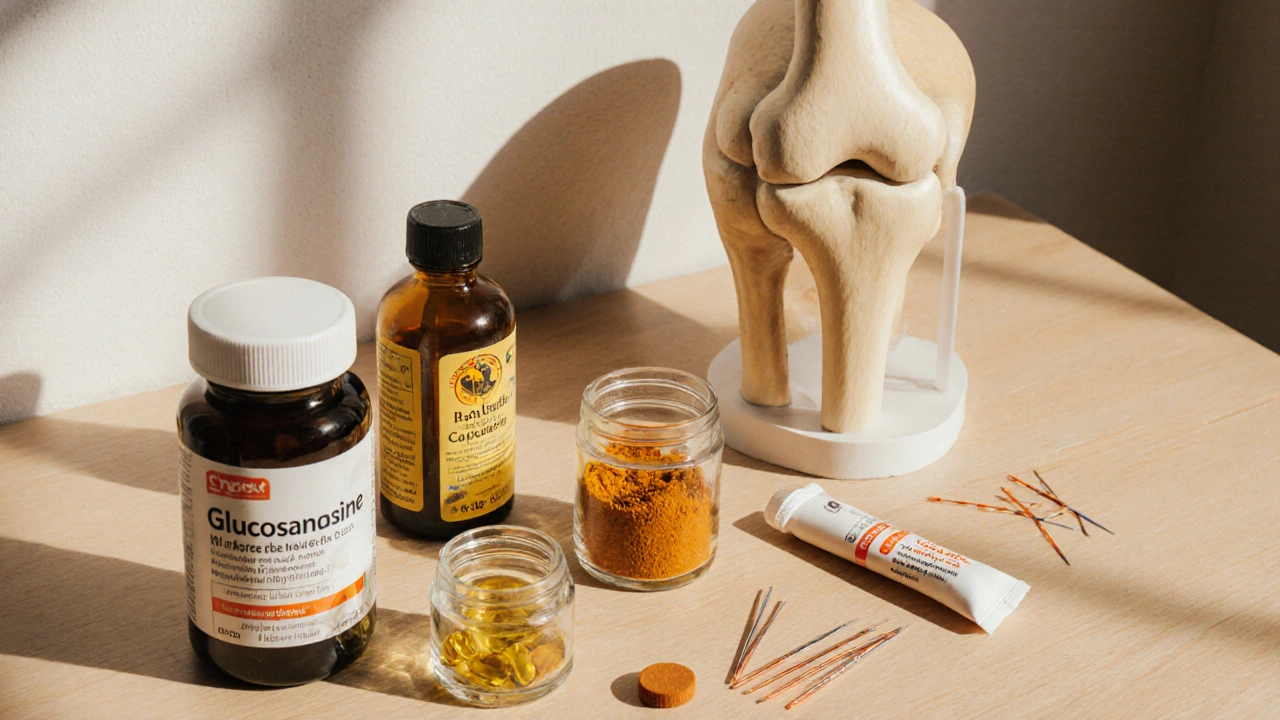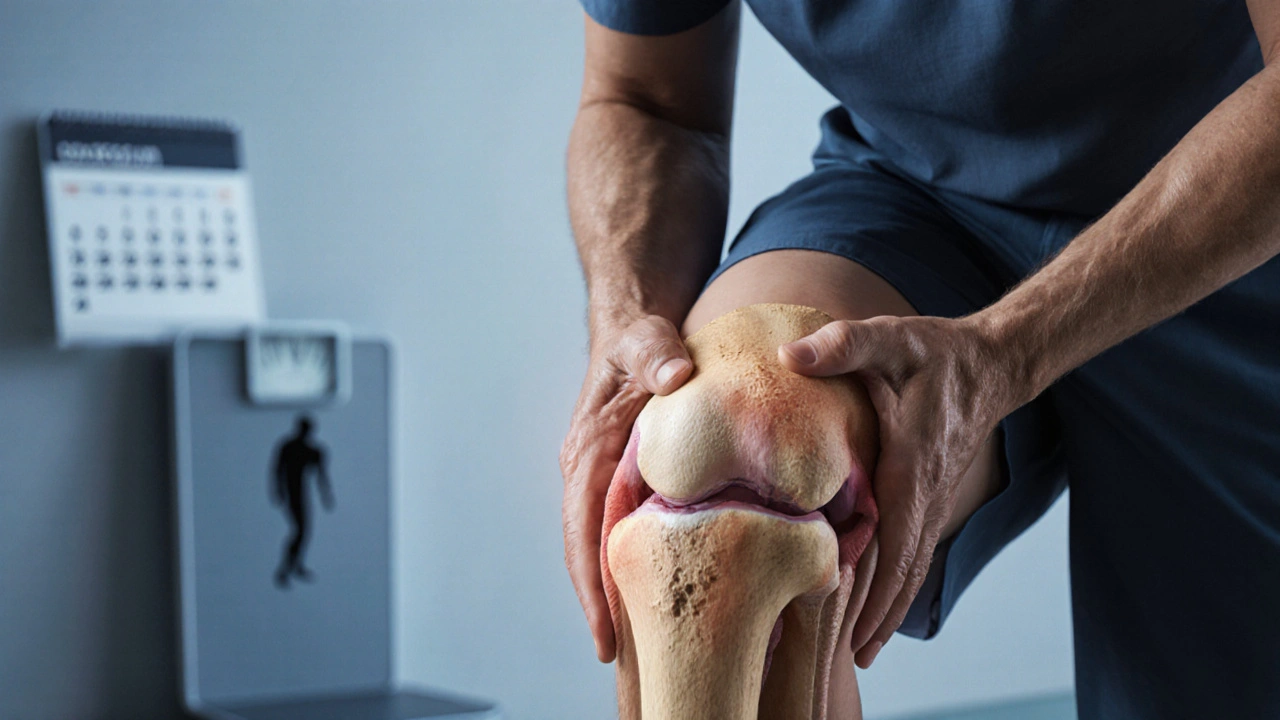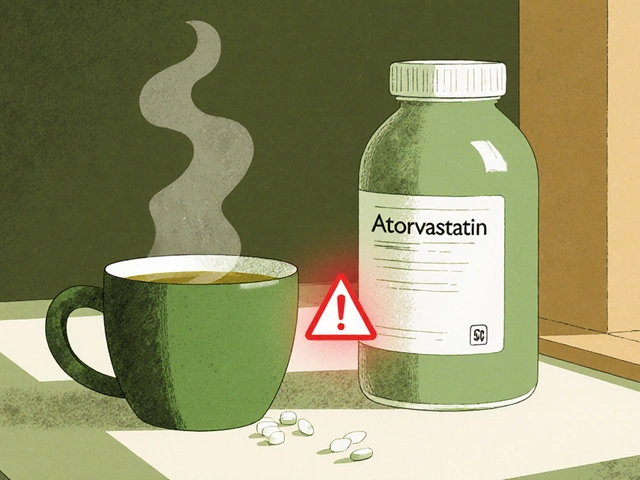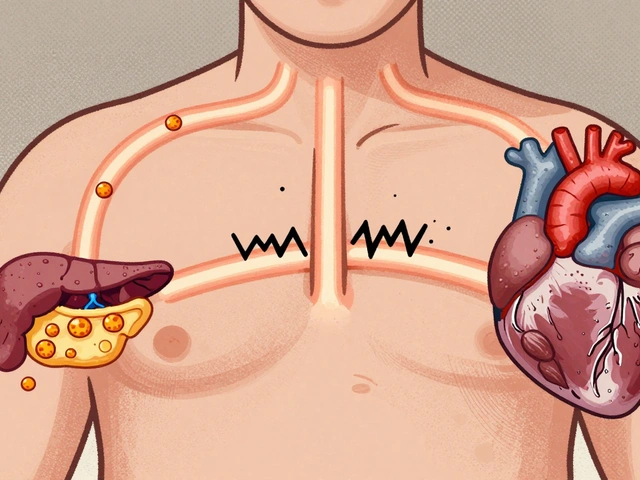Natural OA Remedies Effectiveness Checker
Assess Your Remedy
Select a natural remedy to see its effectiveness rating and recommended usage.
Remedy Analysis
TL;DR:
- Evidence for most natural remedies is mixed; glucosamine, turmeric, and omega‑3s show modest benefit in some studies.
- Safety is generally good, but high doses or poor‑quality supplements can cause stomach upset or interact with blood thinners.
- Combine supplements with movement, weight control, and doctor‑guided monitoring for the best results.
- Acupuncture and topical capsaicin can reduce pain temporarily, especially for mild‑to‑moderate OA.
- Choose reputable brands, start with low doses, and track symptoms for at least 8‑12 weeks.
Osteoarthritis (OA) is a wear‑and‑tear joint disease that most people associate with aging, but it can strike anyone who puts repeated stress on cartilage. The hallmark symptoms-joint pain, stiffness, and reduced mobility-often push patients to look beyond prescription drugs. The question on everybody’s mind is whether natural remedies actually work or if they’re just another hype trend.
Below you’ll find a straight‑forward breakdown of the most talked‑about natural options, the science behind them, practical ways to use them, and the pitfalls to avoid.
Understanding Osteoarthritis
When cartilage breaks down, the underlying bone rubs together, creating inflammation and pain. According to the World Health Organization, OA affects roughly 240 million people worldwide, making it the most common form of arthritis. Risk factors include age, obesity, joint injury, and genetics. While there’s no cure, slowing progression and easing pain are realistic goals.
Key Natural Compounds That People Try
Here’s a quick look at the top contenders:
- Glucosamine is an amino‑sugar that forms part of the cartilage matrix
- Turmeric (curcumin) contains the polyphenol curcumin, known for anti‑inflammatory properties
- Omega‑3 fatty acids EPA and DHA from fish oil modulate inflammatory pathways
- Boswellia serrata is a resinous extract traditionally used in Ayurvedic medicine
- Capsaicin the active component of chili peppers that depletes substance P in nerves
- Acupuncture involves inserting fine needles at specific points to modulate pain signals
What the Science Says
Research on natural OA treatments is a mixed bag. Below is a snapshot of the most credible findings as of 2025.
| Remedy | Study Quality | Typical Dose | Reported Benefit | Common Side Effects |
|---|---|---|---|---|
| Glucosamine | Moderate (several RCTs, mixed outcomes) | 1,500mg daily | Pain reduction 10‑15% in ~40% of users | Stomach upset, rare shellfish allergy |
| Turmeric/Curcumin | High (meta‑analysis 2023, 12 RCTs) | 500‑1,000mg curcumin with piperine | Improved joint stiffness, modest pain relief | Gastro‑intestinal irritation, blood‑thinning effect |
| Omega‑3 Fatty Acids | Medium (several double‑blind trials) | 1,000‑2,000mg EPA/DHA | Reduced inflammatory markers, slight pain drop | Fishy aftertaste, mild bleeding risk at high doses |
| Boswellia serrata | Low‑Medium (small RCTs) | 300‑500mg Boswellic acids | Pain relief comparable to NSAIDs in some trials | Diarrhea, nausea |
| Capsaicin Cream | High (multiple double‑blind studies) | 0.075%-0.1% topical, 3‑4 times daily | Significant pain drop after 2‑4 weeks | Burning sensation, skin irritation |
| Acupuncture | Medium (systematic reviews) | 6‑12 sessions over 4‑6 weeks | Short‑term pain relief, improved range of motion | Minor bruising, rare infection |
Key take‑aways:
- Turmeric and glucosamine have the strongest evidence, though benefits are modest.
- Omega‑3s help by lowering systemic inflammation rather than acting directly on joints.
- Topical capsaicin works quickly for localized pain without systemic side effects.
- Acupuncture offers short‑term relief and can be combined with any supplement regimen.

How to Use Natural Remedies Safely
Even “natural” stuff can cause problems if you ignore dosage, quality, or interactions.
- Start low, go slow. Begin with half the suggested dose for the first week. If you tolerate it, increase to the full amount.
- Check for purity. Look for third‑party testing (USP, NSF) and avoid products with filler herbs that could trigger allergies.
- Mind drug interactions. Omega‑3s and high‑dose turmeric can amplify the effect of blood thinners like warfarin. Always flag new supplements with your physician.
- Track outcomes. Keep a simple journal: note pain level (0‑10), stiffness duration, and any side effects. Review after 8weeks; adjust or stop if there’s no improvement.
Combining Natural Options with Lifestyle Changes
Supplements work best when paired with core OA management strategies.
- Weight control. Losing even 5‑10% of body weight can cut knee‑joint load by 30% and dramatically ease pain.
- Low‑impact exercise. Swimming, cycling, and tai chi improve joint stability without over‑loading cartilage.
- Strength training. Quadriceps‑strengthening exercises (e.g., straight‑leg raises) support the knee and reduce pain episodes.
- Physical therapy. A therapist can teach proper movement patterns, preventing further joint wear.
When you add a supplement like glucosamine, aim for a comprehensive plan: take the supplement with a balanced diet, hit your movement goals, and monitor symptoms. That synergy often makes the difference between “it works a little” and “I feel noticeably better.”
When Natural Remedies Might Not Be Enough
If pain stays above a 6/10 despite 12 weeks of consistent supplement use and exercise, it’s time to talk to a doctor about prescription options (e.g., NSAIDs, hyaluronic acid injections). Also, severe joint damage shown on X‑ray often requires surgical evaluation.
Quick Reference Cheat Sheet
- Best‑studied supplements: Turmeric (with piperine), Glucosamine, Omega‑3 fish oil.
- Fast‑acting topical: 0.075% Capsaicin cream, applied 3‑4 times daily.
- Low‑risk, low‑cost adjunct: Acupuncture (6‑12 sessions).
- Red flags: New severe swelling, sudden loss of function, or pain that worsens at night-seek medical care.

Frequently Asked Questions
Can glucosamine cure osteoarthritis?
No cure exists, but glucosamine may reduce pain modestly in some people. Benefits usually appear after 4‑8 weeks of daily use.
Is turmeric safe for everyone?
Turmeric is generally safe, but high doses can thin blood. People on anticoagulants, gallbladder disease, or severe reflux should consult a doctor first.
How long does capsaicin need to work?
Most users notice a drop in pain after 2‑4 weeks of regular application. Initial burning is normal; it fades as nerve endings adjust.
Do fish oil supplements interfere with NSAIDs?
Both lower inflammation, but combining high-dose fish oil with NSAIDs can raise bleeding risk. Keep fish oil at ≤2g daily and discuss with your clinician.
Is acupuncture covered by insurance in New Zealand?
Some health funds reimburse a limited number of sessions if a GP refers you. Check your policy details before booking.
Bottom line: natural remedies can be part of a sensible OA plan, but they’re not miracle cures. Pick evidence‑backed options, watch the dose, pair them with weight management and movement, and stay in touch with your healthcare provider. With that balanced approach, many people find real, lasting relief.








19 comments
Mariana L Figueroa
If you’re looking to add a supplement, start with a low dose and watch how your joints feel over a few weeks.
mausumi priyadarshini
While many claim turmeric is a miracle, the evidence remains mixed; some trials show modest relief, others report no difference; consequently, one should remain skeptical, especially when marketing hype dominates the discourse.
Josh SEBRING
Honestly, I’ve tossed glucosamine, fish oil, even the spicy capsaicin cream into my routine and barely felt any change – guess the hype beats the science for most folks.
Myra Aguirre
Just track your pain levels daily.
Shawn Towner
One might argue that the so‑called “natural” options are merely placebo‑laden commodities, yet the literature, when scrutinized, reveals that even marginal benefits can justify their modest cost for the discerning patient.
Ujjwal prakash
Look, the studies on boswellia are barely larger than case reports; they’re riddled with small sample sizes, inconsistent dosing, and a lack of long‑term follow‑up-hardly the hallmark of robust evidence!
siddharth singh
When considering any natural remedy for osteoarthritis, the first step is to evaluate the quality of the evidence behind it. Not all supplements are created equal; some have undergone multiple randomized controlled trials, while others linger in anecdotal reports. Glucosamine, for example, has been studied in dozens of trials, yet the results remain heterogeneous, with roughly forty percent of participants reporting a ten to fifteen percent reduction in pain. Turmeric, especially when combined with piperine, enjoys a higher tier of evidence, with meta‑analyses indicating modest improvements in stiffness and pain. Omega‑3 fatty acids work more indirectly by dampening systemic inflammation and may benefit patients with concomitant cardiovascular risk factors. Boswellia serrata shows promise in small studies, but the low‑medium quality of those trials warrants caution. Capsaicin cream, when applied consistently, can produce a noticeable decrease in localized pain after a few weeks, though the initial burning sensation deters some users. Acupuncture provides short‑term relief for many, yet the mechanism remains debated and the benefits often wane without ongoing sessions. Importantly, dosage matters; starting at half the recommended amount mitigates gastrointestinal side effects before titrating up. Purity is another critical factor-third‑party tested brands reduce the risk of contaminants or filler herbs that could trigger allergies. Interactions cannot be ignored; high‑dose turmeric can potentiate the effects of anticoagulants, and excessive fish oil may elevate bleeding risk. Tracking outcomes is essential; a simple daily pain diary helps differentiate true efficacy from placebo. Incorporating these supplements into a broader lifestyle plan-weight management, low‑impact exercise, and strength training-amplifies their potential benefits. If after twelve weeks there is no meaningful improvement, it is prudent to consult a healthcare professional about pharmacologic alternatives. Finally, patient expectations should remain realistic; natural remedies rarely eradicate pain but can modestly improve quality of life when used responsibly.
Angela Green
Just a quick note: the word “supplement” in the original post is misspelled as “supplememt,” and “benefit” should be pluralized in the table header for consistency; otherwise the content is solid.
April Malley
I totally agree with the advice on starting low and monitoring symptoms; it’s a smart approach, especially since every body reacts differently, and keeping a journal can really highlight subtle improvements over time!
scott bradshaw
Sure, just pop a pill and expect miracles.
Crystal Price
Honestly, the whole “natural cure” hype feels like a roller‑coaster of hope and disappointment, and I’ve seen friends get their hearts broken by promises that never delivered.
Murhari Patil
Some say the supplement industry is perfectly honest, yet hidden agendas and undisclosed funding often shape the research we’re fed daily.
kevin joyce
From a mechanistic perspective, the modulation of NF‑κB pathways by curcumin elucidates its anti‑inflammatory potential, yet the bioavailability constraints necessitate adjuncts like piperine to achieve therapeutic plasma concentrations.
michael henrique
The data clearly demonstrate that low‑quality boswellia extracts fail to meet clinical efficacy thresholds, and consumers deserve transparent labeling to avoid wasted expenditure.
Jamie Balish
First off, kudos to anyone taking charge of their joint health; adopting a multi‑modal strategy is the cornerstone of sustainable improvement. Combining evidence‑based supplements with regular low‑impact cardio such as swimming or cycling not only preserves cartilage but also enhances overall metabolic health. Strength training, particularly targeting the quadriceps and hip abductors, creates muscular support that offloads joint stress during daily activities. Weight management remains paramount-shedding even a modest 5‑10 % of body weight can dramatically reduce knee joint loading and pain scores. Consistency is key; a supplement regimen should be followed for at least eight to twelve weeks before drawing conclusions about efficacy. Listening to your body’s feedback-whether it’s a subtle reduction in stiffness or lingering soreness-guides dosage adjustments. Never underestimate the power of proper footwear; shoes with adequate cushioning can complement internal interventions. If you experience any adverse reactions, pause the supplement and consult a clinician to rule out interactions. Remember, the goal isn’t to eradicate pain instantly but to gradually enhance function and quality of life. Lastly, share your journey with supportive communities; collective experiences often uncover practical tips that scientific papers overlook.
Jeff Bellingham
In accordance with established clinical guidelines, it is advisable to reassess therapeutic outcomes after a standard twelve‑week interval before modifying the treatment protocol.
Matthew Balbuena
Yo dude, keep it chill and don’t overthink the pills-just stick to the plan and watch the joint pain melt away like butter on a hot pancake.
michael abrefa busia
Love the positivity! 🌟 Keep crushing those goals and let the joints thank you! 🙌
Bansari Patel
When we reduce the body to a mere collection of biochemical pathways, we forget that pain is as much a narrative as a physiological event, and challenging that narrative can be as potent as any tablet.